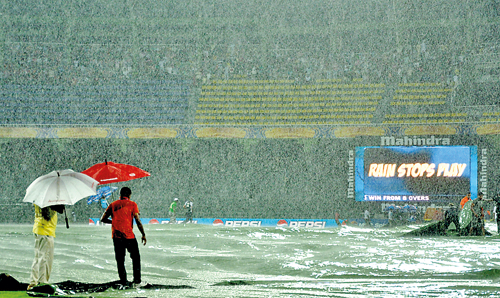Cricket and climate change should not be left to the mercy of Duckworth/Lewis
 The much touted World Cup 2019 did not live up to the expectations of many followers of the game. Although the final was exciting (despite the confusion over the application of rules at its climax) several matches, especially in the League stage, had disappointing endings, mainly due to rain interruptions. Many games were not only disrupted by rain, some were even completely washed out, including two full games of the Lankans. Had, at least, some of these matches been played, the semifinalists or finalists may well have been different! And probably, for the first time in the history of WC Cricket, a semifinal was played on two days. Other matches which were rain interrupted had to be decided on a mathematical formula, the famous (or infamous?) Duckworth-Lewis (D-L) method. All those rain interruptions ruined the enthusiasm of the spectators and caused frustration among the teams. The fickle English summer weather severely affected playing conditions, creating disadvantages to many teams. Rain, naturally, tends to disturb any outdoor sport, but the game of cricket is especially vulnerable, with its longer playing duration, not to mention the effect of changes in weather conditions on the various aspects of the game-batting, bowling, fielding and a phase of a match.
The much touted World Cup 2019 did not live up to the expectations of many followers of the game. Although the final was exciting (despite the confusion over the application of rules at its climax) several matches, especially in the League stage, had disappointing endings, mainly due to rain interruptions. Many games were not only disrupted by rain, some were even completely washed out, including two full games of the Lankans. Had, at least, some of these matches been played, the semifinalists or finalists may well have been different! And probably, for the first time in the history of WC Cricket, a semifinal was played on two days. Other matches which were rain interrupted had to be decided on a mathematical formula, the famous (or infamous?) Duckworth-Lewis (D-L) method. All those rain interruptions ruined the enthusiasm of the spectators and caused frustration among the teams. The fickle English summer weather severely affected playing conditions, creating disadvantages to many teams. Rain, naturally, tends to disturb any outdoor sport, but the game of cricket is especially vulnerable, with its longer playing duration, not to mention the effect of changes in weather conditions on the various aspects of the game-batting, bowling, fielding and a phase of a match.
Were those rain clouds, which hoovered over almost the entirety of the tournament, which impacted on the results of the several games, unusual, even in an English Summer? If so, could the much-blamed cause of all earthly catastrophes “climate change be the culprit? Perhaps yes, climate change – global warming resulting in extreme weather conditions, could be increasingly affecting our much loved- game, not only due to the rain factor, as was the case in the WC, but also due to warming of the atmosphere, producing unusual heat, humidity, which can seriously affect the game. Intense heat leads to dehydration and exhaustion in players, and will also discourage spectator attendance. Instances could arise where heat waves moving over match locations would cause the abandonment of matches.
Air pollution is another global issue which affects cricket, as well as other outdoor games. For instance, a match in Delhi, between Sri Lanka and India was very badly affected due to Air Pollution, Sri Lanka players had to wear masks after some of them stared to vomit! The game also had to be stopped many times, reducing valuable playing time. Performance of players will obviously, be affected by such conditions and, if a star player suffers through foul air or dehydration, his performance will suffer and the very course of the match can change.
Regular interruptions, abandoning of matches, results of matches being decided on mathematical formulae are deterrents to players and spectators alike, and lure sponsors away from cricket to other sports.
Adverse climatic and atmospheric conditions are bound to continue or increase, as the world powers seem to be divided on the issue of addressing the problem of climate change and global warming. It is therefore, up to the administrators of sports, to take whatever measures possible to minimize the impact of the games they administer.
How can Cricket contribute to mitigate these circumstances?
As for air pollution, the Authorities should firstly have a mechanism to check the level of air pollution, which should be within the limits recommended by WHO, so that, players are not exposed to health risks.
The administrators of the game should, at the same time, initiate more sustainable practices, so that, playing competitive cricket will be Carbon neutral. They should be aware of their total Carbon Footprint, and their objective should be to reduce this Carbon Footprint to zero levels.
The following practices could be introduced.
Creating awareness among staff and spectators about degradation of the environment and its impact on climate change, and educate them on good environmental practices.
Discourage non-reusable items such as plastic bottles at matches; declare competitive cricket venues as ‘green’ ‘or plastic/polythene’ free venues. Provide alternative supply of drinking water and other facilities.
Negotiate with transport authorities for additional public transport arrangements during match days, which can reduce excessive vehicle traffic on match days.; discourage entry of private vehicles to the venues.
Proper management of resources such as water and energy; introduce energy efficient systems in all cricket stadiums.
Introduce systems which minimise greenhouse gas emissions, which contribute to global warming and climate change.
Avoid sending rubbish to landfills, by having an efficient garbage disposal system.
Encourage installation of Solar panels at all cricket stadiums, with the objective of 100% power generation through solar power. With proper planning, stadiums could even give excess generation to the National Grid. Wind power generation could also be considered.
Introduce proper rain water harvesting systems and recycle this water for irrigation, pitch and ground maintenance.
Introduce regulations to minimize sound as well as air pollution by banning devices which increases pollution inside the stadiums; implement strict pollution control measures at all events.
The cricketers themselves can set examples and can be ambassadors for good environmental practices.
It is particularly important to ensure that young spectators’ interest is kept alive for the game to prosper. The above practices would help achieve this end, as the young generation is environment friendly by design, rather than by default, and more concerned about the environment than the older generations.
 The ICC and National Cricket Boards should include the issue in their agendas; the assistance of the State and Local Government Authorities need to be obtained; Fund raisers such as ‘benefit’ matches could be considered with the involvement of sponsors; advertisers should be encouraged to participate with environment-friendly practices.
The ICC and National Cricket Boards should include the issue in their agendas; the assistance of the State and Local Government Authorities need to be obtained; Fund raisers such as ‘benefit’ matches could be considered with the involvement of sponsors; advertisers should be encouraged to participate with environment-friendly practices.
Cricket has a bond with the environment and the soil, much more than any other game. That is why it’s a such a beautiful game- the skills, styles and artistry displayed by the players in combating or exploiting the atmospheric conditions and pitch behavior make enthralling stuff, provided, of course, the weather doesn’t become too unpredictable.
The Gentleman’s game must therefore, take the lead in mapping out strategies for the sustainability of, not only the game, but also of the environment and the world in which we live. Cricket will then be known as a Socially responsible sport. Once cricket sets the ball rolling, other sports are bound to follow and, who knows, the rest of the world may, too! Cricket and other sports and the world in general, will then reap the benefits in the long run, leaving a greener Earth and more predictable weather. And, of course, our younger generation would breathe easier!


